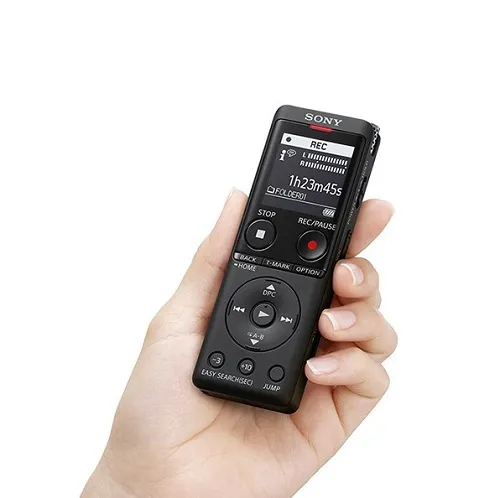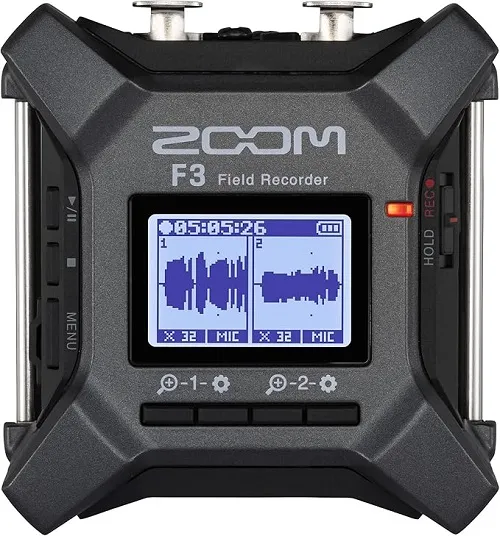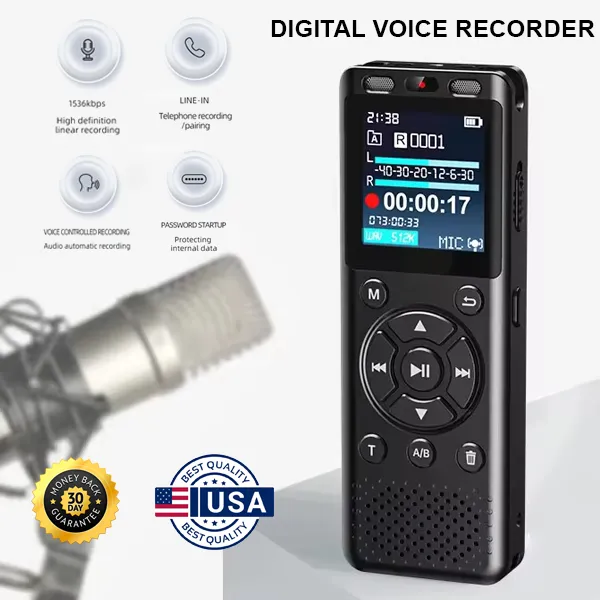Top 5 Best Digital Voice Recorder of 2025: Voice Activated Recorder

From college lectures to work meetings, a digital recorder helps capture audio so you can worry less about furiously scribbling down notes accurately.
We scoured the market before buying the top 11 digital voice recorders to test side-by-side. Then, we started recording and capturing audio notes in the car, bird songs, guitar practice, interviews, and controlled test scenarios.
We compared microphone and audio quality, battery life, file sharing, ease of use, and playback editing features. Below, we share how each of these voice recorders shines and falters, whether you want to record your classes or create world-class podcasts.
Our Testing Process
#1 TOP PICK OF 2025
PROS & CONS
GENERAL VIEW
The EchoNote Digital Voice Recorder delivers peace of mind with every word captured. Amidst a sea of digital recording options, EchoNote rises as a premium, multifunctional solution that fuses advanced audio technology with intuitive user design.
Equipped with professional-grade noise reduction, high-fidelity recording up to 1536Kbps, and versatile format support, it ensures crisp, lossless audio in any environment.
Its robust build, generous battery life, and smart features like voice-activated recording and password protection make it ideal for professionals, students, and content creators alike. This recorder isn’t just functional—it’s thoughtfully engineered for real-world efficiency and secure, seamless audio management.
WRAP-UP
💰 Affordable Pricing – Now Even Better with a Discount!
EchoNote priced just right and now it’s even more attractive with a limited-time discount. Enjoy Free Shipping Nationwide, Get your EchoNote delivered straight to your door at no extra cost.
Order today and get an exclusive 50% OFF discount! Don’t miss out on this limited-time offer!
PICK #2

Sony ICDUX570
“VERY GOOD”
9.5
PROS & CONS
GENERAL VIEW
Our favorite overall digital voice recorder is the compact Sony ICDUX570. It’s an effective, straightforward tool featuring an easy-to-read display and intuitive operating system. Its small size and built-in USB plug make it convenient to use, with a MicroSD slot providing up to 32 gigabytes (GB) of storage, expanding on the already generous 4 GB of internal memory.
We also appreciate its automatic recording templates that optimize the two stereo microphones for specific tasks, whether you’re recording a voice memo, music, meeting, or lecture. It also records in compressed MP3s, saving on storage space and battery life. A useful T-mark button lets you bookmark important moments, and the A-B repeat and slow playback feature make it easier to review recordings. Integrated filters help you clean up your audio.
Though the Sony ICDUX570 picks up background audio in modes like dictation and interview, we found the sounds less brassy and distracting than in several other models. It’s at its best in dictation and lecture modes, making it best suited to taking notes and other simple record-keeping tasks. Our lead tester said, “I found the audio isn’t up to par for professional broadcasting or podcasting.” You can improve recordings using the external microphone input (mini-jack), but it can’t match the 5,000 to 12,000 kbps rates offered by higher-end machines.
Overall, the Sony ICDUX570 is an easy-to-use note-taking device that could serve as a backup for production audio in a pinch.
PICK #3

EVISTR Recorder Mini
“VERY GOOD”
9.0
PROS & CONS
GENERAL VIEW
The EVISTR Voice Activated recorder is one of the smallest devices we’ve tested, at only 2.60 ounces and 3.9 x 1.3 inches, making it easy to have on hand. It also delivers impressive sound quality, making it one of our favorite note-taking recorders in the test.
While it’s not ideal for capturing audio for film or podcast production due to its limited gain control, it could serve as a backup in a pinch, especially if you’re going for a gritty, textured vibe. Its noise reduction setting worked wonderfully during our coffee shop interview test, relegating clattering plates and chatter to the background while keeping both voices clear and prominent in the recording.
Like all the other devices, this recorder is not perfect. Our testers found the user interface far from intuitive, and the user guide can be frustrating to navigate and isn’t particularly helpful. With time, we figured out how to navigate the system, but there are more user-friendly recorders, like the two Sony models we tested. The playback function is especially an issue, often timing out, regardless of which sleep timer setting we chose, forcing us to restart the recording frequently.
Despite these critiques, the EVISTR is a good choice for anyone looking to save money while enjoying some of the best audio quality among the note-taking devices we tested.
PICK #4

Zoom F3 2-input Field Recorder
“GOOD”
8.7
PROS & CONS
GENERAL VIEW
The Zoom F3 records in 32-bit float WAV format, as opposed to the typical 24-bit depth offered by other recorders. This format, combined with its 192 kHz maximum sample rate, collects a massive amount of data in each recording, granting you higher quality recordings and more freedom in post-production. Its wide dynamic range allows you to capture very loud and very quiet sounds without adjusting your gain levels. In fact, Zoom claims that it’s impossible to clip your audio files while using it.
We tested its ability to pick up whispers and saw success bordering on spycraft. Then we headed to the gym, recording conversations over booming pop music and slamming weight machines. “I found it handled the scene beautifully,” our lead tester recalled. “There were no discernible peaks, making it a great option for chaotic field recordings.” Its compact size (3 x 3 x 2 inches) and integrated tripod threads and mounting bars make it easy to add to any setup. A remote-control app (F3 Control) lets you operate the recorder from afar.
While the F3 lacks integrated storage, it accepts MicroSDHC or MicroSDXC cards with up to 1 terabyte (TB) of capacity. It also doesn’t have an integrated mic, so you’ll have to factor one into its already high price. Another consideration is that this recorder has only two XLR inputs. Other models like the Zoom H5 offer up to four more flexible XLR/TRS inputs. Cleaning up your audio with the F3 might also take more time.
While 24-bit recorders like the Zoom H5 have easily accessible gain dials to keep your levels within bounds as you record, you’re encouraged to just hit record and run with the F3. So, you’ll need to even out your levels in post-production. If you prefer quick turnarounds and are recording in a controlled environment, the Zoom H5 could be a better pick due to its integrated microphone and impressive audio quality.
PICK #5

PLAUD Note Voice Recorder
“GOOD”
8.4
PROS & CONS
GENERAL VIEW
When our testers first mounted the PLAUD Note AI Voice Recorder on the back of their smartphone case, their integrated recording app made it seem redundant. Why not just use your phone? It turns out that flipping on a switch is way easier than unlocking your phone and navigating to an app, even if you ask your virtual assistant to do it for you. We found ourselves taking dictation and voice notes on the go way more often.
You have to download the PLAUD app to access your recording, which is labeled by the date and time it was recorded. Clicking on it lets you listen back, and a “Generate” button will transcribe, summarize, and visually map your conversation or notes via ChatGPT.
The whole process is far easier to navigate than traditional models, which haven’t seen a significant update in quite some time. Since you upload your recordings to the cloud, storage space is currently unlimited. A second button lets you choose to record a regular conversation or a phone call.
The included case has a magnetic attachment for your phone, which we knocked off and dropped several times during testing. Luckily, it still works for the time being. If you and your colleagues aren’t worried about brainstorming with ChatGPT in the room, this is certainly a slick option.
HOW WE RANK?
Expert Analysis
Our team of experts highlights useful information so you can easily compare products to find the one that’s right for you.
Award-Winning Tech
Our technology analyzes thousands of purchase trends to bring you the top product recommendations.
Why Trust Our Reviews?
2,200+ shoppers have used Buyer’s Guide in the last week to help find the best products.

Special 50% Off Discount
Due to high demand, EchoNote Digital Voice Recorder is offering a one-time, first-time buyer 50% discount.
Stock levels are low, so act fast!
Here’s Why EchoNote Digital Voice Recorder Are Our #1 Pick!
Superior Recording Quality – Captures Even the Smallest Details: EchoNote uses active noise cancellation, dual-mic recording, and delivers 1536Kbps high-resolution audio — a rare combination in this price range. In our tests, it produced clear, distortion-free sound even in noisy environments like cafés or outdoors.
Minimalist Yet Smart Design: Compact yet durable, EchoNote strikes the perfect balance between elegance and portability. The physical buttons offer satisfying feedback and are easy to use — even for older adults or those unfamiliar with tech.
Long Battery Life, Fast Charging, All-Day Performance: EchoNote can record for many hours on a single charge thanks to its high-capacity battery and support for external memory. During testing, it handled full-day seminars and extended interviews with ease — no worries about running out of power halfway through.
Smart Sync and Convenient File Management: The device supports external memory cards and connects to your computer via USB-C for fast file transfers. One standout feature: automatic file naming by date and time — a huge time-saver for users who record multiple files daily.
Security & Privacy Features: With password-protected recording and auto shut-off after inactivity, EchoNote keeps your recordings safe and secure. It’s ideal for journalists, lawyers, HR professionals, or anyone handling sensitive information.
Benefits of Using Digital Voice Recorder
What To Avoid When Choosing a Digital Voice Recorder


